

Back-to-School Prep: Tips for Helping an Autistic Child Cope with School Change and Uncertainty During COVID
There’s a lot you can do to lessen your autistic child’s angst and have a smoother transition to the new school year.
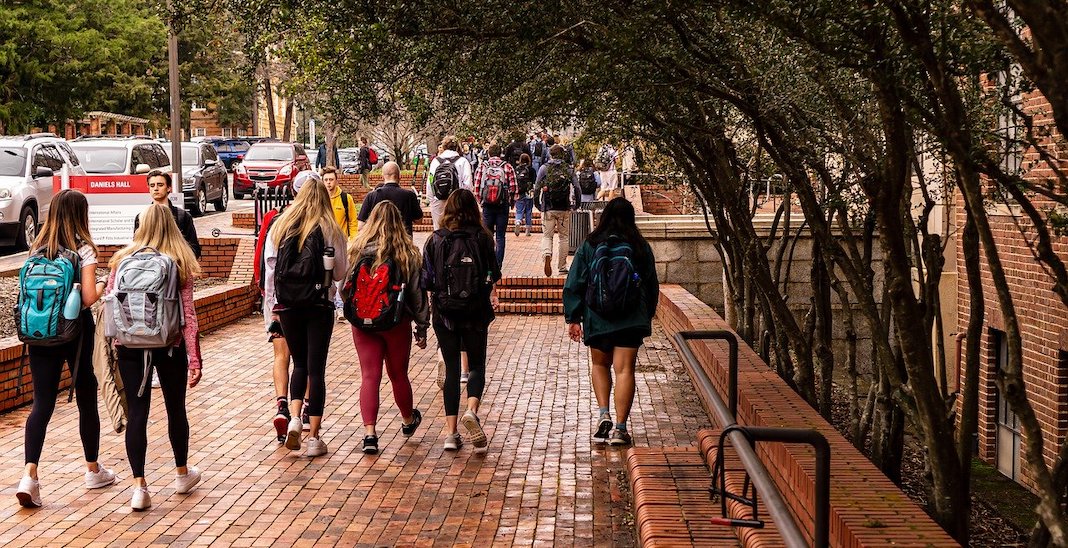
By Jenny Burke — August 3, 2020
Much is unknown and uncertain about the upcoming school year with COVID-19 still rampant. Plans might change, and change quickly (ugh). With all this flux, now more than ever we need to help autistic kids build their coping and flexibility skills, to help them prepare for the school year.
When my child with autism was young, one of my sayings was “Prepare, prepare, prepare” when it came to anything that would be new or different. For these strange and difficult times, you need to prepare your autistic child that change will be a part of the upcoming school year.
BEGIN NOW. Autistic kids often need lots of time to both grasp and get more adjusted to what’s ahead.
MooBoo has compiled tips for how to prepare your autistic child for the upcoming school year. You can also use these for anything coming up that is new or different, because many of the tips will help a child in general build coping and flexibility skills.
Ideally, you would be working closely with your child’s team on these. However, for a lot of reasons (including that school personnel are truly scrambling right now) you might not get as much assistance as your child needs and deserves. While this puts more work on your shoulders, if you have a child who has a really hard time with change in even the best of times, dig deep and put in the time and effort. Being very proactive truly helps your child.
Tips for Preparing Your Autistic Child for the Upcoming and Very Uncertain School Year
1. Identify goals for “Operation Transition Back to School”
This might sound obvious but thinking through, identifying, and writing down your transition goals will help you plan and prioritize. If your child is old enough and developmentally ready, include your child in the process and to help make “I” goals (e.g., “I will develop coping skills to handle change in school”). We should always try—when possible—to have our autistic kids actively participate in anything that concerns them.
Here are examples of goals:
- My child is less anxious about the new school year.
- My child is better able to cope with difference and change.
- My child understands what is expected on the bus and in school in terms of COVID-19 safety.
- My child knows how to properly wear a mask, wash hands, and be socially distant from teachers and other students.
- My child knows who to go to about fears, anxieties, worries, or anger over anything concerning school or COVID-19.
- Here is a goal to have if your child is not able to follow school safety protocols (due to a sensory challenge, anxiety, because they require school-based supports and instruction to learn be compliant, or for some other legitimate reason): By the start of school, my child’s team will fully recognize what my child is/is not capable of doing in terms of school safety protocol and has measures in place to support my child’s safety and emotional well-being. (In current times, achieving this goal will involve a true team effort; throughout the school year, you will have to be very engaged with what’s going on with school and your child’s mental health.)
2. Use visual tools to achieve your goals
Visual tools can really help a lot when it comes to helping a child with autism cope with change. The internet is your friend when it comes to tracking down visual tools that will help. There is no such thing as one-size-fits-all, so not everything will work for your kiddo. Rather than getting overly discouraged and giving up if content is not quite right, create your own by borrowing what you like.
Some helpful visual tools:
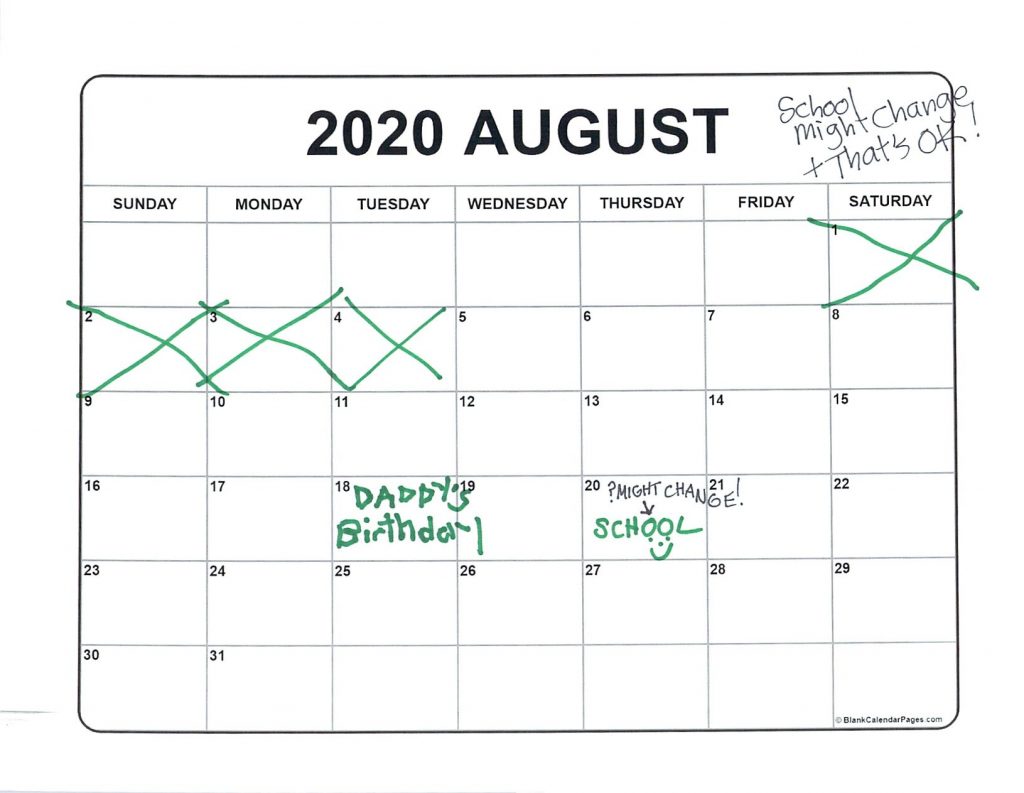
-
A calendar you look at with your child each day, marking off the days til the start of school. Each day, remind your child it’s possible the start date and location of school might change and briefly describe the possible changes. Use the calendar in conjunction with other visuals tools (e.g., as you look at the calendar, refer to a social story you’ve already read together).
-
Social stories you read together. You could make ones about the upcoming school year, COVID-19 safety practices in school, and discussion about how school might suddenly change. Many are free or cost very little like this one.
-
Graphic organizers showing what will be the same and what will be different about the upcoming school year (you might have to use more than one graphic organizer to cover different possible scenarios). Here is a hand-drawn Venn diagram for the purposes of comparing 3rd and 4th grade. I used Venn diagrams frequently when my son was younger to prepare him for something new or different. If he were going into 4th grade right now, this is what we would create.
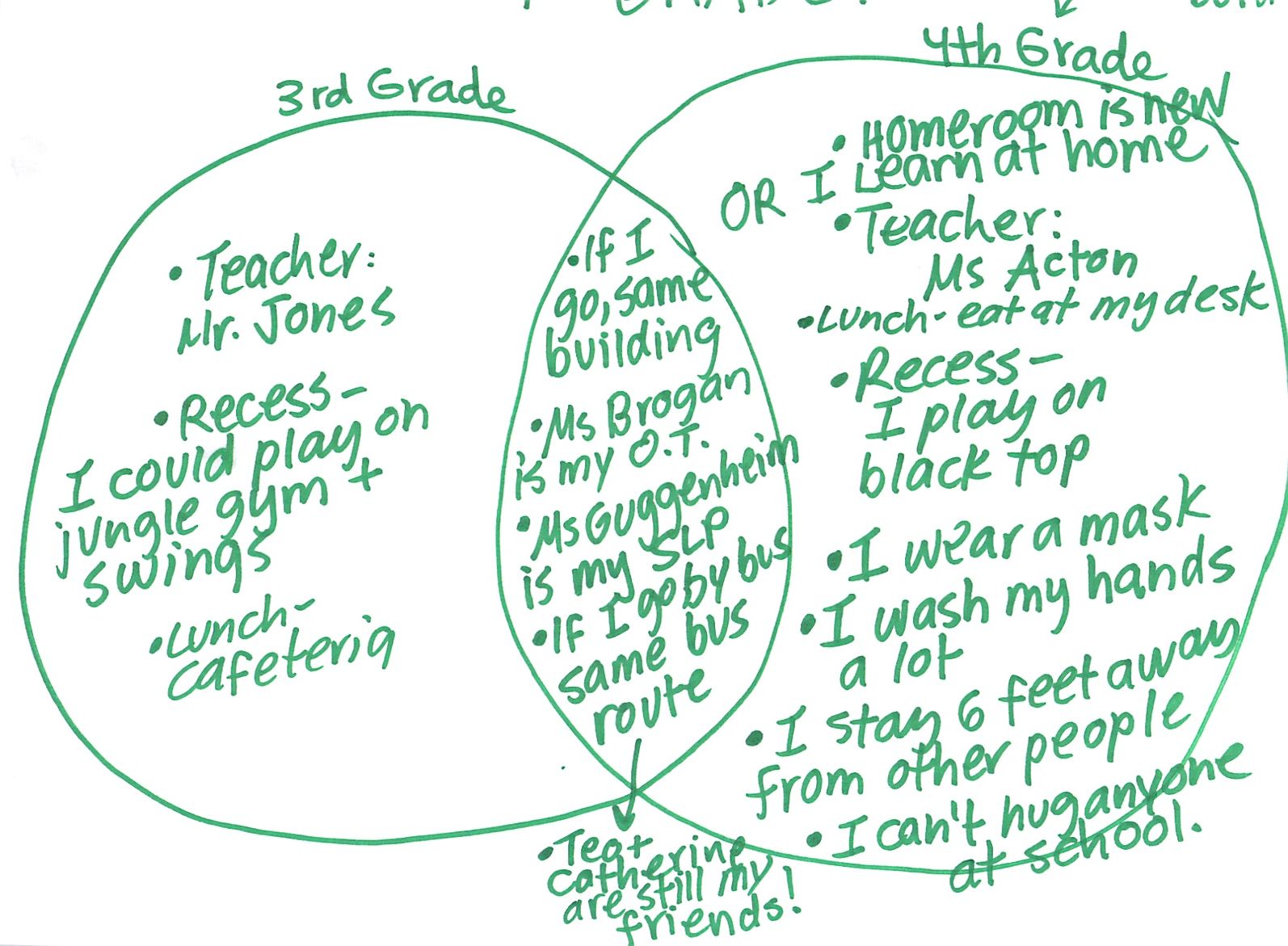
Note how this is not a work of artistic perfection (nor does it need to be!). My son and I would have filled this in together.
- Simple worksheets, drawings, or cartoons a child creates or completes to get familiar with the upcoming school year and possible change. Here is a free, simple worksheet from MooBoo you are welcome to print and use!
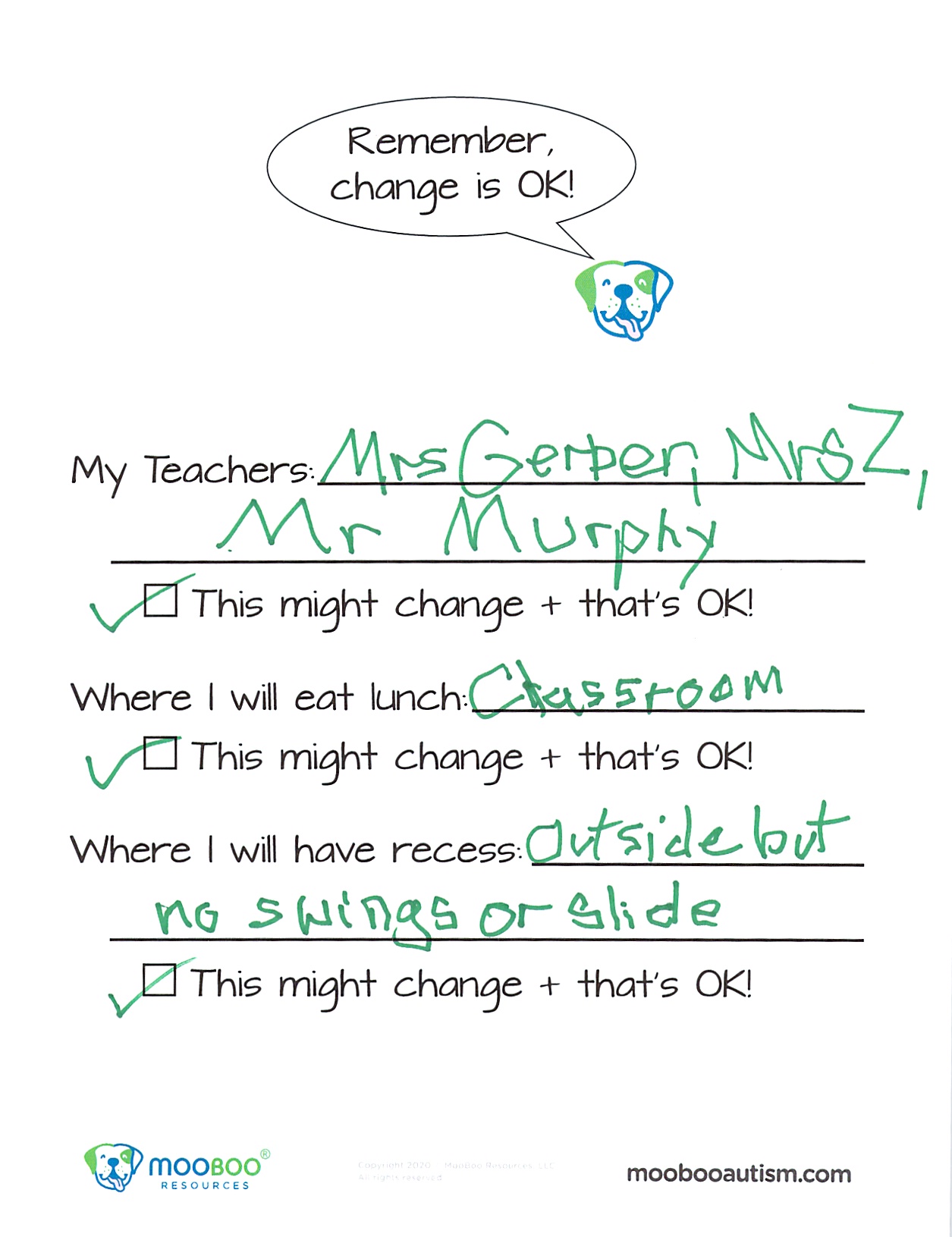
-
YouTube and other videos that model safety protocols like how to wear a mask properly. I love this YouTube video about hygiene, social distancing, and mask-wearing, because it leads with, “stay safe, not scared,” (great message) and there are real kids in the video who demonstrate.
-
Cell phone photos and video of your child and others they know properly social distancing, wearing masks, etc. Include the family and make this fun! Grab a few minutes each day to pull up photos and video on your cell phone to look at them to your child. This is also a great expressive communication practice opportunity!
- Visual schedule(s) of your child’s school day—be it at home, in school, and/or both. Review the schedule(s) daily in the lead up to school. Yes, this will be a challenge in light of all the uncertainty. But if you use a velcro schedule, you can change it more easily, and you can be constantly reminding your child the schedule might change and that’s OK. Additionally, you can begin now with something more general (that includes waking up, getting dressed, breakfast, start of school, lunch, etc.) that can be made more specific as you get more details from your child’s team.
3. Do role play; practice it a little bit each day
There’s a lot you can practice, including how to sit apart on a school bus, how to wear a mask in class, and how to wait in line for lunch in a socially distant way.
Rather than doing a lot of practice right before school starts, strive for about 10-ish minutes each day, starting now! Involve the whole family, make it fun. Take baby steps for things that are hard for your child and try to build up their skill level and tolerance. Do lots of reinforcing (see below) to help improve and speed up the learning process.
4. Schedule school visit(s) to meet with school staff and to go over how the school day will work
While this is an incredibly helpful way to prep a child. Unfortunately, with COVID-19 you might not be able to do this. Try your hardest, though, to get your child in to school before the first day. If going into the school building is not allowed, see if you can get personnel to meet you and your child outside the building to chat, and make sure to talk with them about how things will work.
5. Reinforce your child’s positive coping and flexible behaviors, no matter how small!
I cannot emphasize enough how important it is that you respond positively whenever your child copes, is flexible, wears a mask properly, maintains social distance from others, or demonstrates other positive behaviors. Be sure to use verbal praise that describes what your child did positively (e.g., “Wow, you are doing such a good job being flexible right now! Thanks for using the blue cup because the red one is dirty”).
If you do not know much about reinforcement and how to use it to build your child’s positive behaviors, talk to your child’s team and take a look at Tips & Topics’ “Spotlight: Reinforcement.”
6. Help your child learn deep breathing as a tool to lessen anxiety
Quick story: This Spring when I working on Talking About Thinking, in light of COVID-19 I added content encouraging to kids to take deep breaths when they are feeling scared or worried. I then decided I needed to “walk the walk” and began to do a lot of daily deep breathing. Fast forward to July 4th when I found myself on a Life Flight, not knowing if my loved one would survive an accident. I did a ton of deep breathing and I can tell you this kept me from falling apart (and my loved one did survive and is doing very well!). So, I have become a breathing convert. There is research to support breathing as both a relaxation technique and general wellness tool, for ALL of us.
Practice daily when your child is not anxious. Consider using an app, like MindBell (available in the Google Play store or Apple Store) that makes a lovely, peaceful chime each hour as a cue to stop and breathe deeply. Also, whenever your child becomes fearful, super worried, or anxious, remind them to breathe and, if necessary, hold their hands and breathe with them. Let the team know that you and your child have been practicing deep breathing as a coping tool so they can encourage the use of this in school.
By the way, when YOU are feeling anxious or upset in front of your child, model deep breathing to calm down. Tell your child, “I’m helping myself calm down by taking deep breaths.” I discuss in my last post about what to do after you lose your patience with your child how modeling coping mechanisms (like breathing in order to calm down) is a very important form of in-the-moment teaching.
7. Use mantras
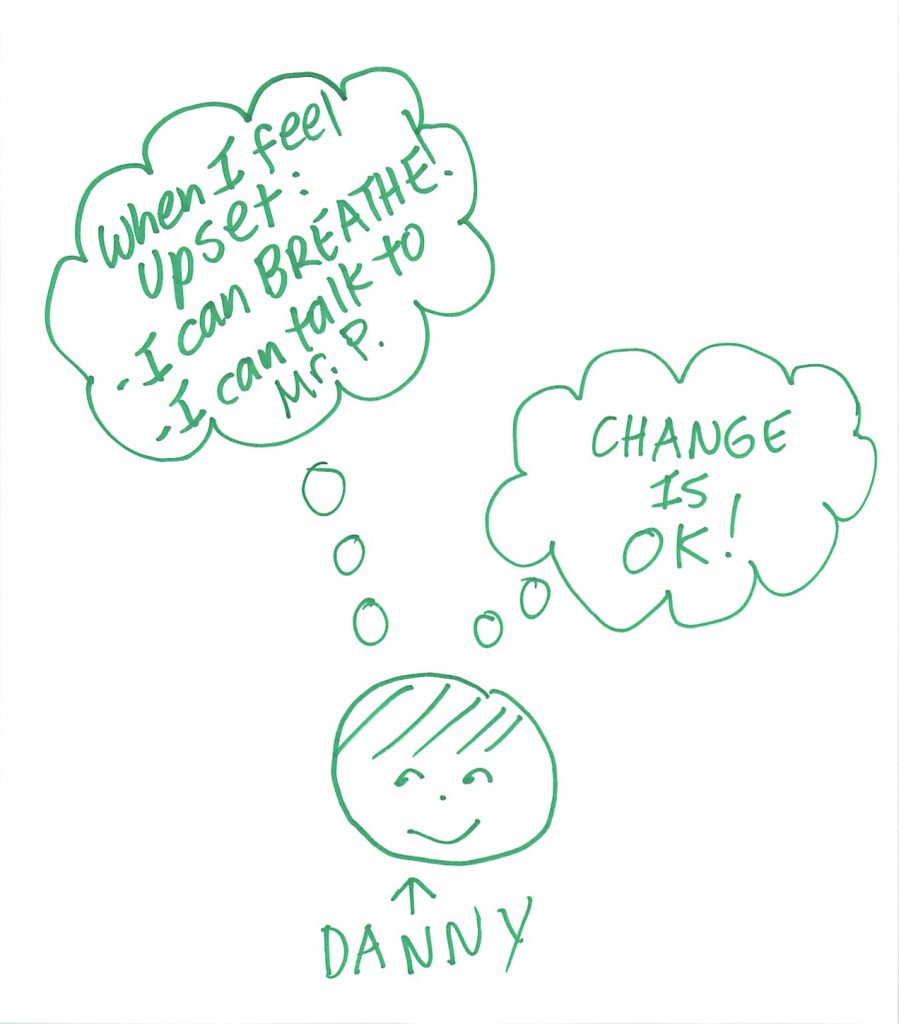
Here is a combo of 4 tips! Here at MooBoo we LOVE: cartoons as a tool, breathing, mantras, and encouraging sharing of thoughts + feelings!
I cannot say enough about how helpful mantras are for certain kids (and adults). A favorite, effective school transition mantra that I used with my child was: “Different is not bad, different is just different.” Variations are “Different is OK” and “Change is OK.” You can say a mantra to your child and, even better, encourage them to say it to themselves as a form of coping.
For more on mantras, check out our Tips & Topics, “Helping a Child Learn to Cope with ‘No.’”
8. Encourage your child to share with someone their school or COVID-19-based fears, anxieties, worries, sadness, or anger
This is a biggie. Kids with autism often struggle with expressive communication as well as managing their feelings. It is critical you do everything you can so they will share with you or another trusted adult what’s on their mind concerning school, COVID-19, or anything else. We have created a very affordable product to help parents with this: Talking About Thinking.
Make sure to consult with your child’s pediatrician or a mental health professional about any concerns over your child’s mood or behaviors, especially if they are new or are intensifying. Kids with autism in the best of times are vulnerable to depression and anxiety, never mind during a pandemic. Here is an excellent, free mental health resource all caregivers should check out.
9. Advocate for your child so they have the supports they need once the school year starts
Every single suggestion above requires your child to somehow adjust or change. It would be extremely unfair and unrealistic to require an autistic child to do all the hard work to make school go as smoothly as possible.
Even in the midst of a pandemic, the school MUST accommodate your child so that they can learn and make progress on their IEP (Individualized Education Plan).
Here is my pep talk to you: Be friendly, be positive. Be accommodating where possible, but be like a dog with a bone on this. By the way, all the above prep puts you in a stronger advocacy position because you will have an excellent sense of: one, what your child can and cannot handle, and two, what your child will need for the school year.
10. Hang in there—Rome was not built in a day
Even as you advocate, have some patience for the school personnel as they navigate a very difficult situation. Definitely have patience for your child! This is why you start as soon as possible. Take baby steps; only do a relatively short amount of prep each day, and provide your child with lots of love and reinforcement. Keep as best you can a sense of humor, and develop your own mantras (“This pandemic will not be forever!”), and BREATHE!
All the best as you tackle this very difficult task of preparing your child for school. Parents, I believe you are up for the job!
We can learn from each other! Please share your thoughts on the above as well as your own advice on what to do when you lose patience with your autistic child.
MooBoo Autism’s mission is to help adults help kids with autism make progress. Be sure to check out our free content. For more about our affordable, parent-friendly digital products learn more here.
Want to know when we post something new? Subscribe here.
Leave A Comment
Please be sure you understand our Comment Policy before posting a comment.You must be logged in to post a comment.